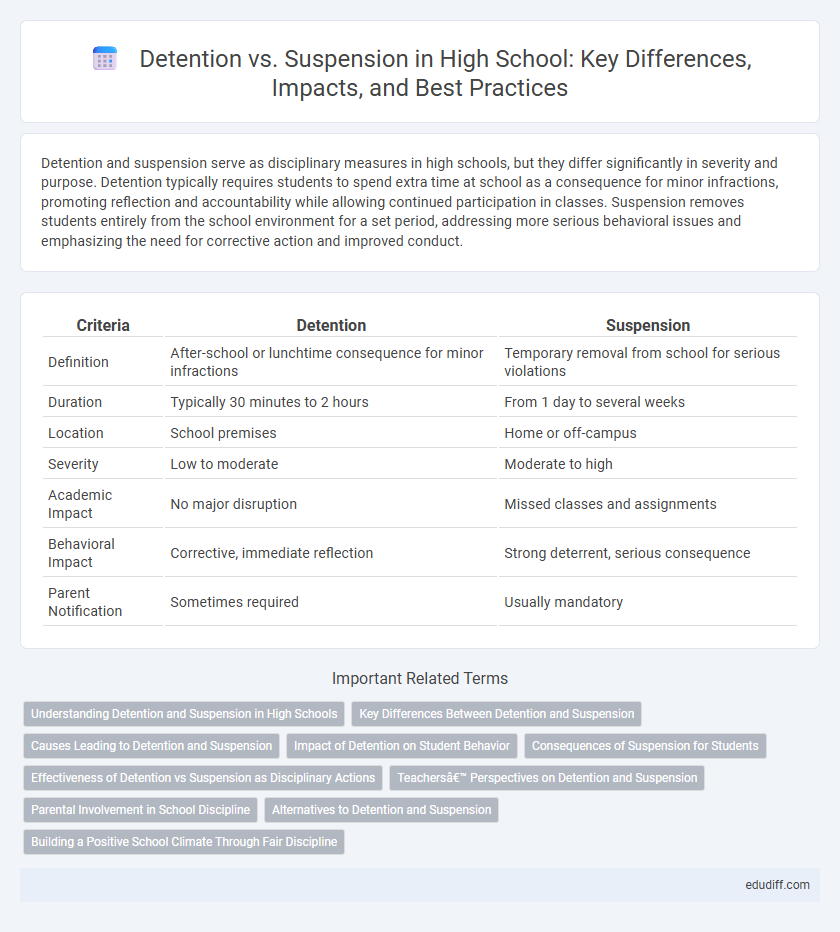Detention and suspension serve as disciplinary measures in high schools, but they differ significantly in severity and purpose. Detention typically requires students to spend extra time at school as a consequence for minor infractions, promoting reflection and accountability while allowing continued participation in classes. Suspension removes students entirely from the school environment for a set period, addressing more serious behavioral issues and emphasizing the need for corrective action and improved conduct.
Table of Comparison
| Criteria | Detention | Suspension |
|---|---|---|
| Definition | After-school or lunchtime consequence for minor infractions | Temporary removal from school for serious violations |
| Duration | Typically 30 minutes to 2 hours | From 1 day to several weeks |
| Location | School premises | Home or off-campus |
| Severity | Low to moderate | Moderate to high |
| Academic Impact | No major disruption | Missed classes and assignments |
| Behavioral Impact | Corrective, immediate reflection | Strong deterrent, serious consequence |
| Parent Notification | Sometimes required | Usually mandatory |
Understanding Detention and Suspension in High Schools
Detention in high schools typically involves students spending extra time after class or school hours as a consequence for minor infractions, aiming to correct behavior without removing them from the educational environment. Suspension, whether in-school or out-of-school, is a more severe disciplinary action that temporarily excludes students from regular classroom activities due to serious misconduct, reflecting the school's effort to maintain safety and order. Understanding the differences between detention and suspension helps students and parents recognize the implications of school policies on academic progress and behavioral expectations.
Key Differences Between Detention and Suspension
Detention requires students to spend additional time at school, typically during lunch or after classes, as a corrective measure for minor infractions, promoting responsibility and reflection. Suspension removes students from the school environment for a set period due to more serious offenses, emphasizing disciplinary consequences and safety. While detention allows continued academic engagement, suspension interrupts learning and often involves parental notification and reintegration plans.
Causes Leading to Detention and Suspension
Detention and suspension in high schools typically result from behavioral issues such as repeated tardiness, disrespect towards staff, and minor rule violations for detention, while suspension is often reserved for more severe offenses like fighting, substance abuse, or repeated defiance of school policies. Schools implement detention as a corrective measure to address less serious infractions and encourage adherence to rules. Suspension serves as a disciplinary action for significant disruptions that compromise the safety and learning environment of the school community.
Impact of Detention on Student Behavior
Detention serves as a corrective measure that encourages students to reflect on their behavior while remaining engaged in the school environment, promoting accountability and consistency. By maintaining attendance during school hours, detention helps to minimize academic disruption and enables educators to monitor improvement closely. Studies indicate that consistent use of detention can reduce minor infractions by fostering immediate consequences without the stigma associated with suspension.
Consequences of Suspension for Students
Suspension from high school results in students missing critical instructional time, which can hinder academic progress and lower overall performance. Extended absences during suspension often lead to gaps in knowledge, increased risk of falling behind peers, and a higher likelihood of disengagement from school activities. Suspensions also negatively impact student records, potentially affecting college admissions and future educational opportunities.
Effectiveness of Detention vs Suspension as Disciplinary Actions
Detention and suspension serve distinct purposes in high school discipline, with detention often providing immediate consequences that allow students to reflect on behavior while maintaining their academic engagement. Suspension removes students from the learning environment, which can hinder academic progress and increase the risk of disengagement from school. Research indicates that detention tends to be more effective for behavior correction by promoting accountability without the negative educational impact associated with suspension.
Teachers’ Perspectives on Detention and Suspension
Teachers often view detention as a constructive disciplinary tool that allows students to reflect on their behavior while maintaining classroom continuity. Suspension is seen as a more severe consequence intended to address serious infractions but can disrupt students' learning and social development. Many educators advocate for detention over suspension to promote accountability without negatively impacting academic progress.
Parental Involvement in School Discipline
Parental involvement in school discipline significantly influences the effectiveness of detention and suspension in high school settings. Schools that engage parents through consistent communication and collaborative behavior management plans tend to see improved student accountability and reduced repeat offenses. Active parental participation fosters a supportive environment that complements disciplinary actions, enhancing students' adherence to school policies.
Alternatives to Detention and Suspension
Alternatives to detention and suspension in high schools include restorative justice programs that promote accountability and conflict resolution among students. Peer mediation and counseling services help address behavioral issues while supporting emotional growth and maintaining student engagement. Implementing these alternatives reduces repeat offenses and minimizes academic disruption, fostering a positive school climate.
Building a Positive School Climate Through Fair Discipline
Implementing fair discipline through appropriate use of detention and suspension fosters a positive school climate by maintaining consistency and promoting accountability among students. Detention, often a corrective measure for minor infractions, encourages reflection and behavior improvement without removing students from the learning environment, whereas suspension is reserved for severe violations, serving as a deterrent while addressing safety concerns. Balancing these disciplinary actions helps high schools create an inclusive atmosphere where students feel supported and understand the consequences of their actions.
Detention vs Suspension Infographic

 edudiff.com
edudiff.com